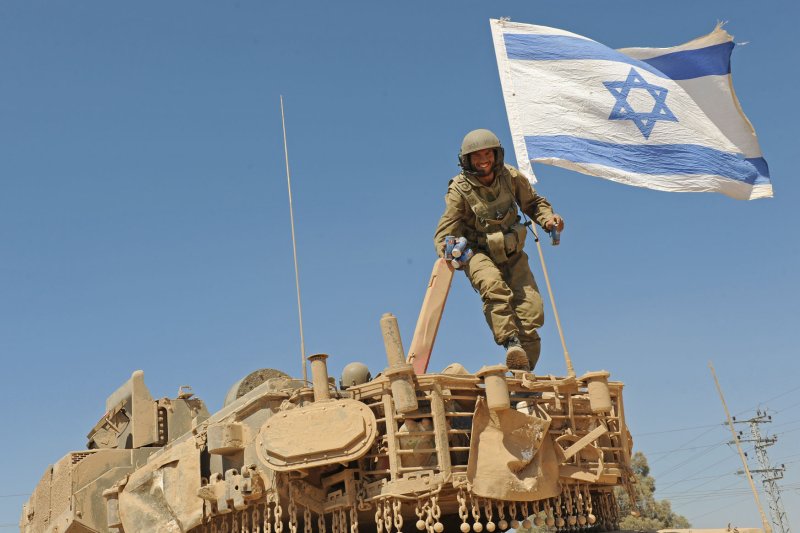If David's Sling is soon deployed alongside Iron Dome batteries, Israel will have the theoretical ability to knock out all variants of a surface-to-surface missile in Hezbollah's arsenal. File Photo by Debbie Hill/UPI |
License Photo
BEIRUT, Lebanon -- Israel's midlevel anti-missile system known as David's Sling is close to becoming operational just as tensions are building once more between the United States and Iran.
The system passed its final tests in January amid expectations that it could soon be deployed to defend sensitive sites in Israel against Hezbollah's arsenal of missiles and rockets, estimated by Israel at about 140,000 of all types.
David's Sling is a midlevel anti-missile system, wedged between Iron Dome, which is designed to shoot down short-range rockets, and the Arrow system, which targets ballistic missiles outside Earth's atmosphere, Israel's first line of defense.
In January, the Israeli Air Force deployed its first units of the Arrow 3, the latest and most advanced weapon of the anti-missile armory
At the end of January, Iran fired a Khorramshahr medium-range missile, the first test launch since U.S. President Donald Trump took office. Trump tweeted that Iran was "playing with fire."
Michael Flynn, then U.S. national security adviser, said the Trump administration was putting Iran "on notice" and the U.S. government imposed fresh sanctions on companies and individuals connected to Iran's ballistic program. In response, Iran conducted further test-firings on Feb. 4.
"The recent test was in line with our plans and we will not allow foreigners to interfere with our defense plans," Iranian Defense Minister Hossein Dehghan said Feb. 6.
Iran and Hezbollah have long depended on rockets and missiles as a form of deterrence against Israel. Since the end of the 34-day war in 2006 between Hezbollah and Israel, the Lebanese group is believed to have amassed new and longer-range missiles, some fitted with guidance capabilities.
In February 2016, Hezbollah Secretary-General Hassan Nasrallah warned that his organization "has the ability to cover the entirety of occupied Palestine with missiles. We must keep this capability because it acts as a deterrent for the third Lebanon war."
If David's Sling is soon deployed alongside Iron Dome batteries, Israel will have the theoretical ability to knock out all variants of a surface-to-surface missile in Hezbollah's arsenal.
Israel's anti-missile network, however, cannot overcome the strategic challenge posed by Hezbollah's rockets, which is not related to the number of casualties caused nor the amount of damage inflicted but to shutting down the Jewish state.
In February 2000, three months before Israel abandoned a border strip it had occupied in Lebanon since 1978, a surge of Israeli casualties triggered air attacks against Lebanese infrastructure targets.
Expecting Hezbollah to swiftly launch a barrage of Grad rockets into northern Israel in reprisal, the Israeli government ordered a 48-hour state of emergency in which some 300,000 residents were moved to bomb shelters.
Hezbollah never fired the rockets. Instead, the mere threat was sufficient to paralyze northern Israel. About 80 percent of the population of Kiryat Shmona, the main town in northern Galilee, had fled the expected bombardment. Economic losses ran at $2.4 million a day.
The presence of a multi-tier anti-missile defense system arrayed across northern and central Israel will not change these strategic problems if another war breaks out. Israeli intelligence estimates that Hezbollah will attempt to fire up to 1,500 missiles a day in that conflict.
Hezbollah would be expected to launch its short-range weapons, with a reach of up to 43 miles, in swarms to overwhelm anti-missile batteries. Even if Iron Dome and David's Sling achieve an 80 percent hit rate against the predicted onslaught, that would leave 300 projectiles striking Israeli territory daily, compelling civilians to seek cover.
In the past, the threatened areas in Israel were limited to the far north but given the longer range of many Hezbollah rockets today, all of Israel is under threat.
In the event of another war, Israel will be effectively paralyzed with airports and seaports closed and schools and businesses across the country shut for the duration of the conflict.
Israel's influential Institute for National Security Studies concluded in January that Hezbollah's vast arsenal of missiles and rockets "are turning Hezbollah into the most severe threat currently facing the [Israeli military] in particular and Israel in general."
Given the scale of the threat, some analysts say Israel must keep the conflict as short as possible by unleashing its air force to wreak unrestricted havoc across Lebanon — far in excess of the destruction wrought in 2006 — to force Hezbollah to stop.
"The results of the third Lebanese war will be devastating," Giora Eiland, former head of Israel's National Security Council, warned in 2016.
"A war declared between Israel and Lebanon, where Hezbollah is part of the national political infrastructure, will cause great damage to Lebanon, which nobody's interested in — not Lebanon, not the U.S., not Europe, Syria or Iran."
This article originally appeared at The Arab Weekly.















